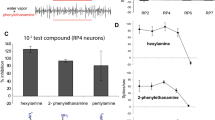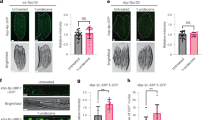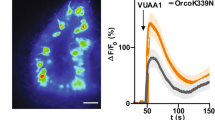Abstract
The fruitfly Drosophila melanogaster exhibits a robust and innate olfactory-based avoidance behaviour to CO2, a component of odour emitted from stressed flies1. Specialized neurons in the antenna and a dedicated neuronal circuit in the higher olfactory system mediate CO2 detection and avoidance1,2. However, fruitflies need to overcome this avoidance response in some environments that contain CO2 such as ripening fruits and fermenting yeast, which are essential food sources. Very little is known about the molecular and neuronal basis of this unique, context-dependent modification of innate olfactory avoidance behaviour. Here we identify a new class of odorants present in food that directly inhibit CO2-sensitive neurons in the antenna. Using an in vivo expression system we establish that the odorants act on the Gr21a/Gr63a CO2 receptor3. The presence of these odorants significantly and specifically reduces CO2-mediated avoidance behaviour, as well as avoidance mediated by ‘Drosophila stress odour’. We propose a model in which behavioural avoidance to CO2 is directly influenced by inhibitory interactions of the novel odours with CO2 receptors. Furthermore, we observe differences in the temporal dynamics of inhibition: the effect of one of these odorants lasts several minutes beyond the initial exposure. Notably, animals that have been briefly pre-exposed to this odorant do not respond to the CO2 avoidance cue even after the odorant is no longer present. We also show that related odorants are effective inhibitors of the CO2 response in Culex mosquitoes that transmit West Nile fever and filariasis. Our findings have broader implications in highlighting the important role of inhibitory odorants in olfactory coding, and in their potential to disrupt CO2-mediated host-seeking behaviour in disease-carrying insects like mosquitoes.
This is a preview of subscription content, access via your institution
Access options
Subscribe to this journal
Receive 51 print issues and online access
$199.00 per year
only $3.90 per issue
Buy this article
- Purchase on Springer Link
- Instant access to full article PDF
Prices may be subject to local taxes which are calculated during checkout




Similar content being viewed by others
References
Suh, G. S. B. et al. A single population of olfactory sensory neurons mediates an innate avoidance behaviour in Drosophila . Nature 431, 854–859 (2004)
Suh, G. S. et al. Light activation of an innate olfactory avoidance response in Drosophila . Curr. Biol. 17, 905–908 (2007)
Jones, W. D., Cayirlioglu, P., Kadow, I. G. & Vosshall, L. B. Two chemosensory receptors together mediate carbon dioxide detection in Drosophila . Nature 445, 86–90 (2007)
Guerenstein, P. G. & Hildebrand, J. G. Roles and effects of environmental carbon dioxide in insect life. Annu. Rev. Entomol. 53, 161–178 (2008)
Hallem, E. A. & Sternberg, P. W. Acute carbon dioxide avoidance in Caenorhabditis elegans . Proc. Natl Acad. Sci. USA 105, 8038–8043 (2008)
Clyne, P., Warr, C. & Carlson, J. Candidate taste receptors in Drosophila . Science 287, 1830–1834 (2000)
Scott, K. et al. A chemosensory gene family encoding candidate gustatory and olfactory receptors in Drosophila . Cell 104, 661–673 (2001)
Kwon, J. Y., Dahanukar, A., Weiss, L. A. & Carlson, J. R. The molecular basis of CO2 reception in Drosophila . Proc. Natl Acad. Sci. USA 104, 3574–3578 (2007)
Faucher, C., Forstreuter, M., Hilker, M. & de Bruyne, M. Behavioral responses of Drosophila to biogenic levels of carbon dioxide depend on life-stage, sex and olfactory context. J. Exp. Biol. 209, 2739–2748 (2006)
Golding, J. B., Shearer, D., Wyllie, S. G. & McGlasson, W. B. Application of 1-MCP and propylene to identify ethylene-dependent ripening processes in mature banana fruit. Postharvest Biol. Technol. 14, 87–98 (1998)
Golding, J. B., Shearer, D., McGlasson, W. B. & Wyllie, S. G. Relationships between respiration, ethylene, and aroma production in ripening banana. J. Agric. Food Chem. 47, 1646–1651 (1999)
Fischler, W., Kong, P., Marella, S. & Scott, K. The detection of carbonation by the Drosophila gustatory system. Nature 448, 1054–1057 (2007)
Katz, D. B. et al. Receptors, circuits, and behaviors: new directions in chemical senses. J. Neurosci. 28, 11802–11805 (2008)
Larsson, M. C. et al. Or83b encodes a broadly expressed odorant receptor essential for Drosophila olfaction. Neuron 43, 703–714 (2004)
Benton, R., Sachse, S., Michnick, S. W. & Vosshall, L. B. Atypical membrane topology and heteromeric function of Drosophila odorant receptors in vivo . PLoS Biol. 4, e20 (2006)
Mayr, D., Mark, T., Lindinger, W., Brevard, H. & Yeretzian, C. Breath-by-breath analysis of banana aroma by proton transfer reaction mass spectrometry. Int. J. Mass Spectrom. 223–224, 743–756 (2003)
Galliard, T., Matthew, J. A., Wright, A. J. & Fishwick, M. J. Enzymic breakdown of lipids to volatile and nonvolatile carbonyl fragments in disrupted tomato fruits. J. Sci. Food Agric. 28, 863–868 (1977)
Martineau, B., Henick-Kling, T. & Acree, T. Reassessment of the influence of malolactic fermentation on the concentration of diacetyl in wines. Am. J. Enol. Vitic. 46, 385–388 (1995)
Nykanen, L. & Nykanen, I. in Volatile Compounds in Foods and Beverages (ed. Maarse, H.) 548–580 (Dekker, 1991)
Hughes, P. S. & Baxter, E. D. in Beer: Quality, Safety and Nutritional Aspects 40–73 (Royal Society of Chemistry, 2001)
Carde, R. T. Odour plumes and odour-mediated flight in insects. Ciba Found. Symp. 200, 54–66; discussion 66–70 (1996)
de Bruyne, M., Foster, K. & Carlson, J. Odor coding in the Drosophila antenna. Neuron 30, 537–552 (2001)
Hallem, E. A. & Carlson, J. R. Coding of odors by a receptor repertoire. Cell 125, 143–160 (2006)
Lu, T. et al. Odor coding in the maxillary palp of the malaria vector mosquito. Anopheles gambiae. Curr. Biol. 17, 1533–1544 (2007)
Zwiebel, L. J. & Takken, W. Olfactory regulation of mosquito–host interactions. Insect Biochem. Mol. Biol. 34, 645–652 (2004)
Cooperband, M. F. & Carde, R. T. Orientation of Culex mosquitoes to carbon dioxide-baited traps: flight manoeuvres and trapping efficiency. Med. Vet. Entomol. 20, 11–26 (2006)
Robertson, H. M. & Kent, L. B. Evolution of the gene lineage encoding the carbon dioxide receptor in insects. J. Insect Sci. 19, 1–14 (2009)
Dobritsa, A. A., van der Goes van Naters, W., Warr, C. G., Steinbrecht, R. A. & Carlson, J. R. Integrating the molecular and cellular basis of odor coding in the Drosophila antenna. Neuron 37, 827–841 (2003)
Acknowledgements
We thank W. van der Goes van Naters for help with setting up our electrophysiology rig, P. Atkinson and A. Kahlon for providing mosquitoes, J. Millar for providing reagents, and A. Dahanukar for commenting on the manuscript.
Author Contributions S.L.T. planned and performed the experiments and co-wrote the manuscript. A.R. planned the experiments, supervised the project and co-wrote the manuscript.
Author information
Authors and Affiliations
Corresponding author
Supplementary information
Supplementary Information
This file contains Supplementary Figures 1-6 with Legends, Supplementary Tables 1-2 and Supplementary References. (PDF 378 kb)
Rights and permissions
About this article
Cite this article
Turner, S., Ray, A. Modification of CO2 avoidance behaviour in Drosophila by inhibitory odorants. Nature 461, 277–281 (2009). https://doi.org/10.1038/nature08295
Received:
Accepted:
Published:
Issue Date:
DOI: https://doi.org/10.1038/nature08295
Comments
By submitting a comment you agree to abide by our Terms and Community Guidelines. If you find something abusive or that does not comply with our terms or guidelines please flag it as inappropriate.



